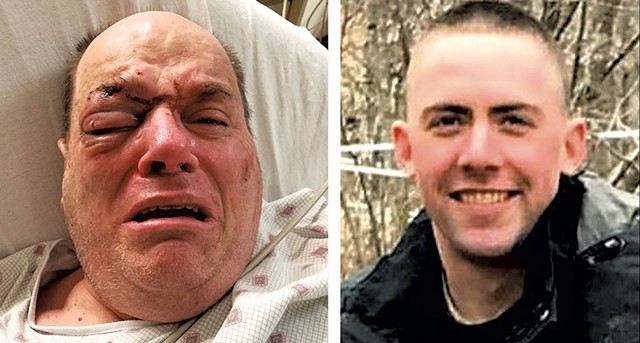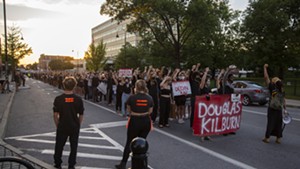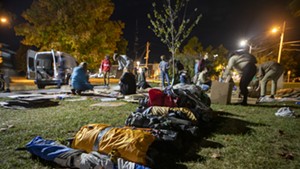
- Courtesy Of Lisa Webber | Burlington Police Department
- Douglas Kilburn (left) Officer Cory Campbell
Burlington Police Chief Brandon del Pozo has depicted Douglas Kilburn as an irate man who picked a fistfight with an officer outside the University of Vermont Medical Center and received "a few" punches in return. The cop, Cory Campbell, handcuffed Kilburn within seconds and took him into the emergency room, where he was treated overnight for what del Pozo described as "small, non-displaced" skull fractures.
Kilburn's sister, Lisa Webber, took a cellphone photo of her 54-year-old brother in a hospital bed about an hour after the altercation. Kilburn's right eye looks like bruised fruit; his nose is swollen, and there's dried blood along his brow. His jaw was broken in several places, and his eye socket was fractured, according to his sister.
She wants the world to see that photo. In her mind, Kilburn's battered face shows that police haven't been entirely forthcoming about what happened on March 11.
"I don't understand why they had to beat him so bad," she said.
Kilburn died two days later, on March 14. It was the day before he was scheduled to return to the hospital for surgery to stabilize his eye socket with a titanium plate, his sister said. Police found him dead in bed at home in Burlington's Northgate Apartments. The television was still on.
Del Pozo placed Campbell on administrative duty and asked the Vermont State Police to independently investigate circumstances around the death. But the chief has not stayed out of their way.
On April 10, the state's chief medical examiner, Steven Shapiro, officially linked Kilburn's death to Campbell's fist by ruling his manner of death a homicide. Shapiro's determination was not a simple one: He was unable to identify the immediate cause of death but attributed it to several underlying factors, including hypertension, obesity, diabetes, vascular disease and skull fractures due to blunt-force trauma.
Shapiro explained the findings to del Pozo by phone before releasing them publicly, but the chief was not satisfied. Emails obtained by Seven Days revealed that del Pozo contacted Shapiro's boss, Vermont Health Commissioner Mark Levine, to say he and Burlington Mayor Miro Weinberger believed the medical examiner's homicide finding was wrong. When that didn't work, Weinberger tried to convince the governor's office to delay public release of the autopsy results until the city could press its argument.
Those efforts backfired, instead raising questions about why a chief with a reputation for progressive policing would try to flex political muscle over an independent investigation.
"The more that we hear about how much the chief has tried to intervene in the investigation, the more uncomfortable we have become," said Jason Gibbs, chief of staff to Gov. Phil Scott. "It's just not appropriate for the representative of an organization that is the subject of an investigation to influence it. This is something that is instilled in law enforcement officers at the introductory level."
Gibbs continued: "It really, at our level, seems to be a poor choice, and as I indicated in my response to the mayor's office, we have concerns that this type of activity borders on unethical."
Del Pozo insisted that he was not trying to strong-arm the state, just to ensure that it hadn't screwed up. He intervened, he said, because news of the "homicide" classification, while not a criminal finding, threatened to negatively affect public perception.
"The allegation that we were seeking to influence the manner of death says that we were merely acting out of self-interest or to protect our liability," del Pozo told Seven Days. "It's to offer a clear and correct picture to our community that we serve."
Del Pozo's version of events begins with Campbell responding to a call about a disorderly man. Kilburn was at the emergency room arguing with hospital security staff about visiting a family member who was a patient. Campbell successfully negotiated Kilburn's entrance before moving on to another matter. While arranging transportation for another person to a wet shelter, Campbell encountered Kilburn in the parking lot, again arguing with hospital security. Kilburn's car was parked in the ambulance bay.
Kilburn punched Campbell in the face, and Campbell threw a few punches back, del Pozo said. He quickly subdued the man, cuffed him and took him inside for treatment. Campbell cited Kilburn for disorderly conduct, trespassing and assaulting an officer. Campbell was uninjured.
Webber said she struggles to understand how her brother, a tall, heavyset man whom she called "Boog," could have been an attacker who had to be subdued violently.
She knew Kilburn not as a hulking threat but as a bighearted former softball star physically compromised by health issues. Kilburn's occupation was listed on his death certificate as pipe fitter, but he'd been out of work and on disability for years. Diabetes had forced the amputation of three toes on his right foot.
A stroke about 18 months ago had left him with limited use of his left side and a noticeable limp. He had seizures. He could be inappropriately loud.
Webber said Kilburn went to the hospital on March 11 for two reasons: to see his wife, who was in the hospital, and to intercept her brother, who would likely be visiting. The brother-in-law owed Kilburn money. Webber was concerned about a potential conflict, so she followed Kilburn there in a separate car. She said Kilburn found the relative smoking outside the emergency room and confronted him. They argued loudly, drawing a security guard's attention. Eventually Kilburn calmed down enough that Webber decided she could keep a dinner date with her daughter. She left as Kilburn walked inside to visit his wife. She never saw Campbell.
About an hour later, Webber got a call from Kilburn. Through tears, he told her to come to the ER. She almost couldn't recognize his swollen face. "He said, 'That cop punched me, and the cop told me to shut my fat effing mouth,'" she recalled. "That's the thing that stuck in Doug's mind."
Del Pozo's summary was based on evidence that isn't publicly available while the incident is under investigation. The detail about the size of Kilburn's skull fractures — small — was culled from the medical examiner's autopsy report, which has not been released. The description of the number of punches Campbell threw — a few — was based on unreleased bodycam and surveillance footage.
As investigators, state police control what evidence gets released and when. They tend to reveal very little in the process. By contrast, del Pozo's general inclination is "to say as much as we can to the public" without harming the case, the chief said. So while del Pozo is quick to call state police to investigate cases involving his officers, he hasn't fully recused himself from shaping the narrative that emerges — even when the state asks him not to talk.
"The state police would prefer that we just not make any comments at all about anything. We just don't think that's appropriate to our community," del Pozo said. "To say somebody has died as the result of police activity [without] even saying anything about what happened and why? I think that tips the balance a little too far, to say we're going to be silent for the sake of an investigation."
In this case, del Pozo took a step further, seeking to maintain control over what facts to release while also challenging an unflattering medical conclusion.
Del Pozo appears to have conducted his own mini-investigation into the autopsy findings, even soliciting second opinions from medical examiners in New York and California, whom he declined to identify. In an email to Levine, del Pozo said both backed his view that Shapiro's homicide finding was in error. However, del Pozo was mistaken in a key piece of his argument to the health commissioner, a national expert told Seven Days last week. The chief said medical examiners must be certain "beyond a reasonable doubt" when classifying a death as a homicide. "'Beyond a reasonable doubt' shouldn't be brought into this," said Dr. Jonathan Arden, president of the National Association of Medical Examiners, a private accrediting body.
Vermont's medical examiner office has been fully accredited by NAME since 1978. Levine said he has "complete faith" in the office, which Shapiro has led since 2006. The Vermont Department of Health said Shapiro would not comment, but he's been quoted rather bluntly in the past on the topic of cops' understanding of his profession.
"Police make terrible death investigators," Shapiro told the Charlotte Observer in 2014 for that newspaper's series about flaws in North Carolina's coroner system.
Thomas Anderson, Vermont's public safety commissioner, saw the city's autopsy meddling as merely the latest in a "very troubling" pattern of del Pozo "inserting himself" into the Kilburn investigation, according to his April 10 email to the governor's staff. Through a spokesperson, Anderson declined to elaborate.
Del Pozo said Anderson might have been referring to a disagreement over whether Campbell should be allowed to view police bodycam video of the incident before giving a statement to investigators. State police instructed the chief not to hand it over, and del Pozo complied, denying last Friday a public records request by Campbell's attorney, Rich Cassidy, to provide the video.
On Monday, the Burlington Police Officers Association sued in state court to force release of the bodycam footage and other video, presumably the hospital's, that captured the incident.
"I cannot recommend that Officer Campbell voluntarily submit to an interview unless I first have an opportunity to review the video camera recording, in the presence of a qualified use of force instructor," Cassidy wrote to the city attorney's office in an April 3 email filed with the court record.
Cassidy did not return a call for comment.
Critics say the practice of allowing police to review video evidence can taint officer testimony, though some departments, including Burlington's, allow it. Vermont State Police policy does not.
The bodycam footage and autopsy dispute underscore how friction can arise when an investigation involves law enforcement agencies with differing policies and practices.
State police don't have written policies that govern the handover of cases from local police departments, nor does the agency communicate expectations to the investigated agency. "We conduct investigations of law enforcement officers as we would any other criminal investigation," public information officer Adam Silverman told Seven Days in an email. Vermont State Police's major crimes unit is handling the Kilburn investigation, he said.
But cases involving police officers aren't like most others, said American Civil Liberties Union of Vermont staff attorney Lia Ernst.
"Almost by definition, when an independent investigation is taking place, it's a high visibility or politically controversial subject," she said. "That's where real guidance and restrictions and protocols are needed most."
Explicit policies that clarify expectations could help prevent the appearance or actual exercise of undue influence by an investigated agency. What is particularly harmful, Ernst said, is to selectively release information that supports one side of the story.
That's how it feels to Webber, who is frustrated that the accounts of the incident she sees in the news haven't explained — or fully described — the injuries to Kilburn's face.
"I want justice for him," she said.
The police union supports how del Pozo has challenged the medical examiner's office.
Its president, Dan Gilligan, was the first to publicly challenge the autopsy findings that del Pozo disputed behind the scenes. And even if Kilburn did die as a result of Campbell's punches, Gilligan wrote in an April 10 press release, it's a "sad but unfortunate consequence of Kilburn's own conduct."
"I think it is reasonable and prudent to be asking questions this way," he said, referring to the chief. "It's appreciated by our members."















Comments (29)
Showing 1-25 of 29
Comments are closed.
From 2014-2020, Seven Days allowed readers to comment on all stories posted on our website. While we've appreciated the suggestions and insights, right now Seven Days is prioritizing our core mission — producing high-quality, responsible local journalism — over moderating online debates between readers.
To criticize, correct or praise our reporting, please send us a letter to the editor or send us a tip. We’ll check it out and report the results.
Online comments may return when we have better tech tools for managing them. Thanks for reading.